Report on Human Resources Development: Learning, Training at Tesco
VerifiedAdded on 2023/03/31
|18
|4861
|422
Report
AI Summary
This report provides a comprehensive overview of human resources development, focusing on learning styles, training methods, and evaluation techniques within an organizational context, specifically referencing Tesco. It compares different learning styles, explains the role of the learning curve, and assesses the contribution of learning styles in designing training events. The report also compares training needs at different organizational levels, evaluates the advantages and disadvantages of various training methods, and outlines a systematic approach to planning training and development. Furthermore, it covers the preparation and execution of training event evaluations, reviews the success of evaluation methods, and explains the government's role in training and lifelong learning. The impact of the competency movement and contemporary training initiatives on human resources development are also assessed, providing a holistic view of enhancing employee skills and achieving organizational goals. Desklib offers similar resources for students.
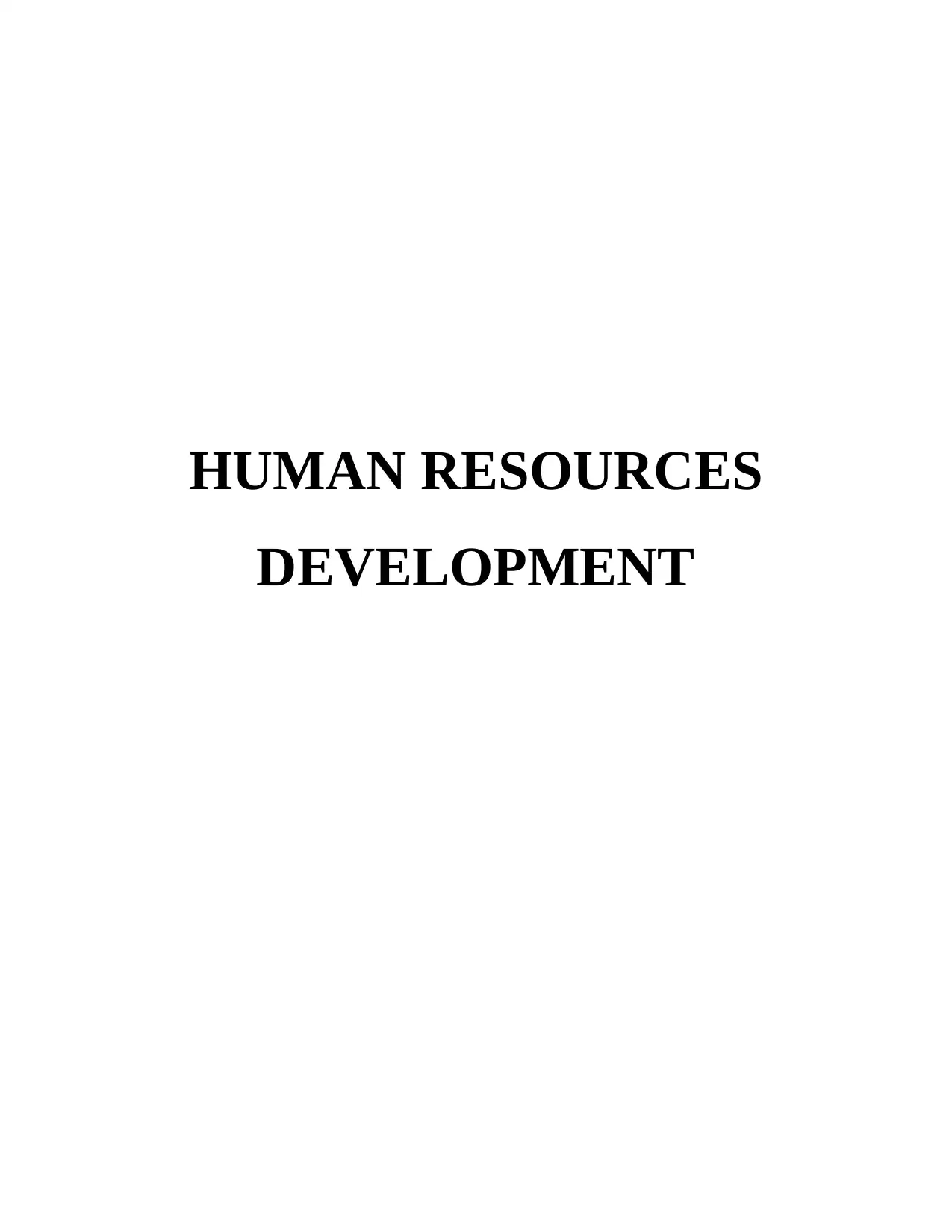
HUMAN RESOURCES
DEVELOPMENT
DEVELOPMENT
Paraphrase This Document
Need a fresh take? Get an instant paraphrase of this document with our AI Paraphraser
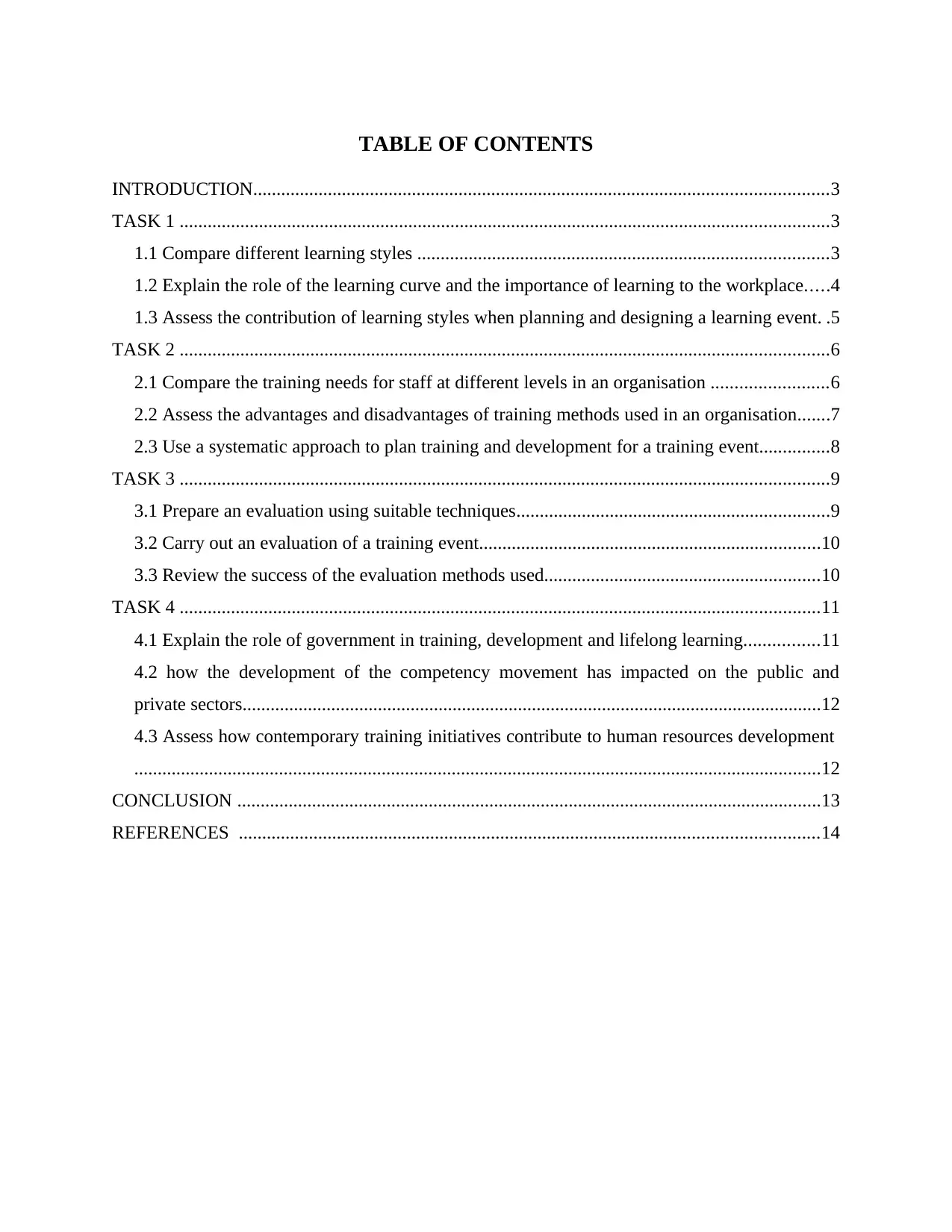
TABLE OF CONTENTS
INTRODUCTION...........................................................................................................................3
TASK 1 ...........................................................................................................................................3
1.1 Compare different learning styles ........................................................................................3
1.2 Explain the role of the learning curve and the importance of learning to the workplace.....4
1.3 Assess the contribution of learning styles when planning and designing a learning event. .5
TASK 2 ...........................................................................................................................................6
2.1 Compare the training needs for staff at different levels in an organisation .........................6
2.2 Assess the advantages and disadvantages of training methods used in an organisation.......7
2.3 Use a systematic approach to plan training and development for a training event...............8
TASK 3 ...........................................................................................................................................9
3.1 Prepare an evaluation using suitable techniques...................................................................9
3.2 Carry out an evaluation of a training event.........................................................................10
3.3 Review the success of the evaluation methods used...........................................................10
TASK 4 .........................................................................................................................................11
4.1 Explain the role of government in training, development and lifelong learning................11
4.2 how the development of the competency movement has impacted on the public and
private sectors............................................................................................................................12
4.3 Assess how contemporary training initiatives contribute to human resources development
...................................................................................................................................................12
CONCLUSION .............................................................................................................................13
REFERENCES ............................................................................................................................14
INTRODUCTION...........................................................................................................................3
TASK 1 ...........................................................................................................................................3
1.1 Compare different learning styles ........................................................................................3
1.2 Explain the role of the learning curve and the importance of learning to the workplace.....4
1.3 Assess the contribution of learning styles when planning and designing a learning event. .5
TASK 2 ...........................................................................................................................................6
2.1 Compare the training needs for staff at different levels in an organisation .........................6
2.2 Assess the advantages and disadvantages of training methods used in an organisation.......7
2.3 Use a systematic approach to plan training and development for a training event...............8
TASK 3 ...........................................................................................................................................9
3.1 Prepare an evaluation using suitable techniques...................................................................9
3.2 Carry out an evaluation of a training event.........................................................................10
3.3 Review the success of the evaluation methods used...........................................................10
TASK 4 .........................................................................................................................................11
4.1 Explain the role of government in training, development and lifelong learning................11
4.2 how the development of the competency movement has impacted on the public and
private sectors............................................................................................................................12
4.3 Assess how contemporary training initiatives contribute to human resources development
...................................................................................................................................................12
CONCLUSION .............................................................................................................................13
REFERENCES ............................................................................................................................14

⊘ This is a preview!⊘
Do you want full access?
Subscribe today to unlock all pages.

Trusted by 1+ million students worldwide
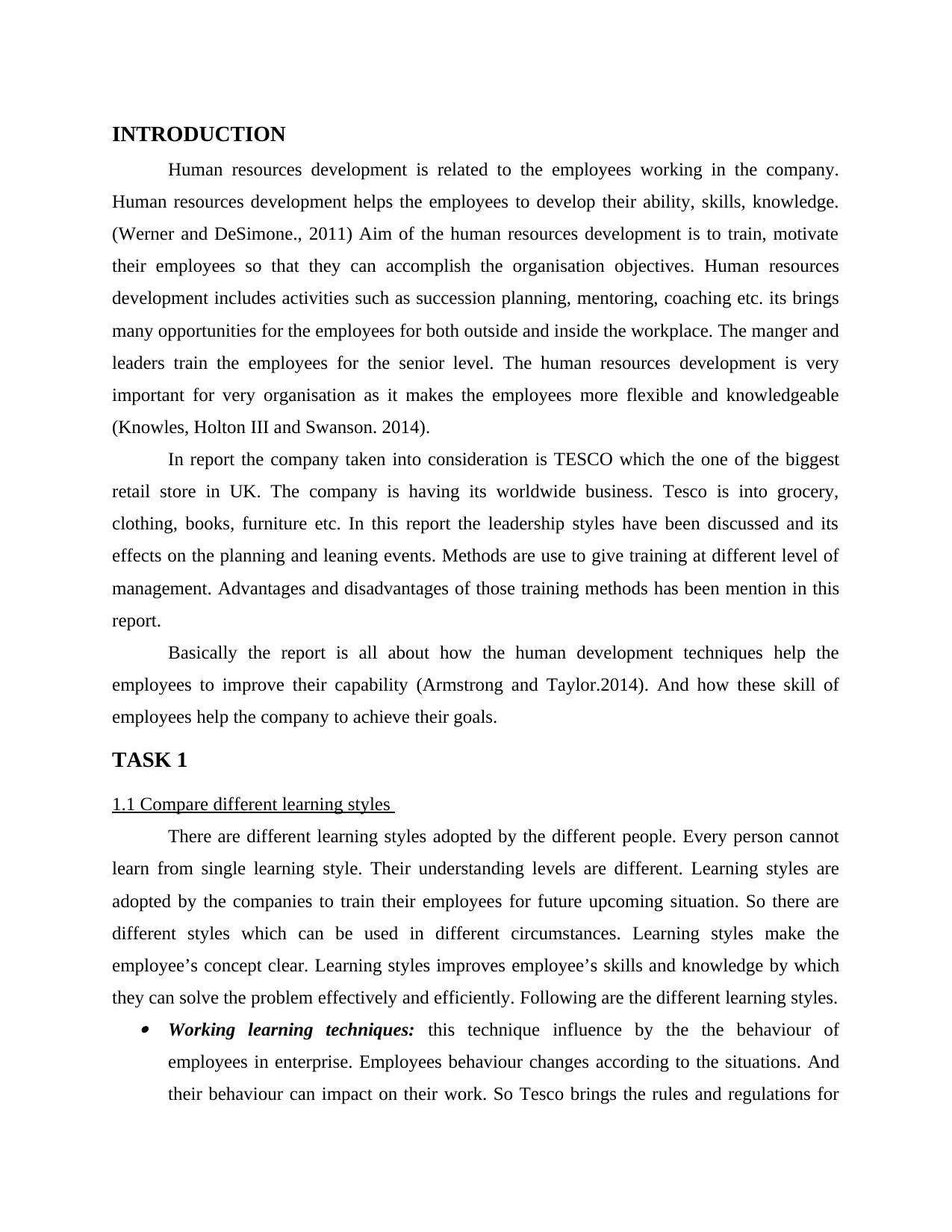
INTRODUCTION
Human resources development is related to the employees working in the company.
Human resources development helps the employees to develop their ability, skills, knowledge.
(Werner and DeSimone., 2011) Aim of the human resources development is to train, motivate
their employees so that they can accomplish the organisation objectives. Human resources
development includes activities such as succession planning, mentoring, coaching etc. its brings
many opportunities for the employees for both outside and inside the workplace. The manger and
leaders train the employees for the senior level. The human resources development is very
important for very organisation as it makes the employees more flexible and knowledgeable
(Knowles, Holton III and Swanson. 2014).
In report the company taken into consideration is TESCO which the one of the biggest
retail store in UK. The company is having its worldwide business. Tesco is into grocery,
clothing, books, furniture etc. In this report the leadership styles have been discussed and its
effects on the planning and leaning events. Methods are use to give training at different level of
management. Advantages and disadvantages of those training methods has been mention in this
report.
Basically the report is all about how the human development techniques help the
employees to improve their capability (Armstrong and Taylor.2014). And how these skill of
employees help the company to achieve their goals.
TASK 1
1.1 Compare different learning styles
There are different learning styles adopted by the different people. Every person cannot
learn from single learning style. Their understanding levels are different. Learning styles are
adopted by the companies to train their employees for future upcoming situation. So there are
different styles which can be used in different circumstances. Learning styles make the
employee’s concept clear. Learning styles improves employee’s skills and knowledge by which
they can solve the problem effectively and efficiently. Following are the different learning styles. Working learning techniques: this technique influence by the the behaviour of
employees in enterprise. Employees behaviour changes according to the situations. And
their behaviour can impact on their work. So Tesco brings the rules and regulations for
Human resources development is related to the employees working in the company.
Human resources development helps the employees to develop their ability, skills, knowledge.
(Werner and DeSimone., 2011) Aim of the human resources development is to train, motivate
their employees so that they can accomplish the organisation objectives. Human resources
development includes activities such as succession planning, mentoring, coaching etc. its brings
many opportunities for the employees for both outside and inside the workplace. The manger and
leaders train the employees for the senior level. The human resources development is very
important for very organisation as it makes the employees more flexible and knowledgeable
(Knowles, Holton III and Swanson. 2014).
In report the company taken into consideration is TESCO which the one of the biggest
retail store in UK. The company is having its worldwide business. Tesco is into grocery,
clothing, books, furniture etc. In this report the leadership styles have been discussed and its
effects on the planning and leaning events. Methods are use to give training at different level of
management. Advantages and disadvantages of those training methods has been mention in this
report.
Basically the report is all about how the human development techniques help the
employees to improve their capability (Armstrong and Taylor.2014). And how these skill of
employees help the company to achieve their goals.
TASK 1
1.1 Compare different learning styles
There are different learning styles adopted by the different people. Every person cannot
learn from single learning style. Their understanding levels are different. Learning styles are
adopted by the companies to train their employees for future upcoming situation. So there are
different styles which can be used in different circumstances. Learning styles make the
employee’s concept clear. Learning styles improves employee’s skills and knowledge by which
they can solve the problem effectively and efficiently. Following are the different learning styles. Working learning techniques: this technique influence by the the behaviour of
employees in enterprise. Employees behaviour changes according to the situations. And
their behaviour can impact on their work. So Tesco brings the rules and regulations for
Paraphrase This Document
Need a fresh take? Get an instant paraphrase of this document with our AI Paraphraser
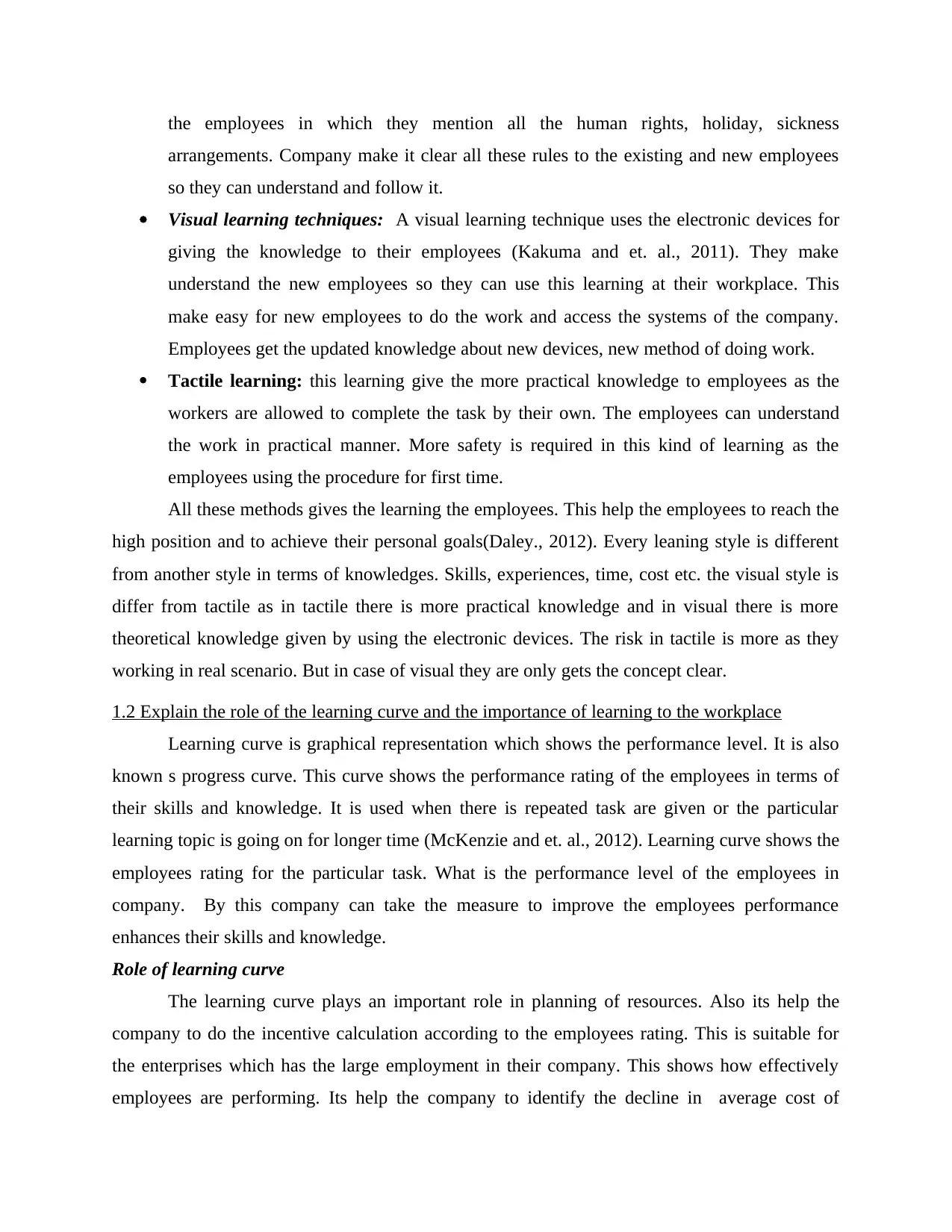
the employees in which they mention all the human rights, holiday, sickness
arrangements. Company make it clear all these rules to the existing and new employees
so they can understand and follow it.
Visual learning techniques: A visual learning technique uses the electronic devices for
giving the knowledge to their employees (Kakuma and et. al., 2011). They make
understand the new employees so they can use this learning at their workplace. This
make easy for new employees to do the work and access the systems of the company.
Employees get the updated knowledge about new devices, new method of doing work.
Tactile learning: this learning give the more practical knowledge to employees as the
workers are allowed to complete the task by their own. The employees can understand
the work in practical manner. More safety is required in this kind of learning as the
employees using the procedure for first time.
All these methods gives the learning the employees. This help the employees to reach the
high position and to achieve their personal goals(Daley., 2012). Every leaning style is different
from another style in terms of knowledges. Skills, experiences, time, cost etc. the visual style is
differ from tactile as in tactile there is more practical knowledge and in visual there is more
theoretical knowledge given by using the electronic devices. The risk in tactile is more as they
working in real scenario. But in case of visual they are only gets the concept clear.
1.2 Explain the role of the learning curve and the importance of learning to the workplace
Learning curve is graphical representation which shows the performance level. It is also
known s progress curve. This curve shows the performance rating of the employees in terms of
their skills and knowledge. It is used when there is repeated task are given or the particular
learning topic is going on for longer time (McKenzie and et. al., 2012). Learning curve shows the
employees rating for the particular task. What is the performance level of the employees in
company. By this company can take the measure to improve the employees performance
enhances their skills and knowledge.
Role of learning curve
The learning curve plays an important role in planning of resources. Also its help the
company to do the incentive calculation according to the employees rating. This is suitable for
the enterprises which has the large employment in their company. This shows how effectively
employees are performing. Its help the company to identify the decline in average cost of
arrangements. Company make it clear all these rules to the existing and new employees
so they can understand and follow it.
Visual learning techniques: A visual learning technique uses the electronic devices for
giving the knowledge to their employees (Kakuma and et. al., 2011). They make
understand the new employees so they can use this learning at their workplace. This
make easy for new employees to do the work and access the systems of the company.
Employees get the updated knowledge about new devices, new method of doing work.
Tactile learning: this learning give the more practical knowledge to employees as the
workers are allowed to complete the task by their own. The employees can understand
the work in practical manner. More safety is required in this kind of learning as the
employees using the procedure for first time.
All these methods gives the learning the employees. This help the employees to reach the
high position and to achieve their personal goals(Daley., 2012). Every leaning style is different
from another style in terms of knowledges. Skills, experiences, time, cost etc. the visual style is
differ from tactile as in tactile there is more practical knowledge and in visual there is more
theoretical knowledge given by using the electronic devices. The risk in tactile is more as they
working in real scenario. But in case of visual they are only gets the concept clear.
1.2 Explain the role of the learning curve and the importance of learning to the workplace
Learning curve is graphical representation which shows the performance level. It is also
known s progress curve. This curve shows the performance rating of the employees in terms of
their skills and knowledge. It is used when there is repeated task are given or the particular
learning topic is going on for longer time (McKenzie and et. al., 2012). Learning curve shows the
employees rating for the particular task. What is the performance level of the employees in
company. By this company can take the measure to improve the employees performance
enhances their skills and knowledge.
Role of learning curve
The learning curve plays an important role in planning of resources. Also its help the
company to do the incentive calculation according to the employees rating. This is suitable for
the enterprises which has the large employment in their company. This shows how effectively
employees are performing. Its help the company to identify the decline in average cost of
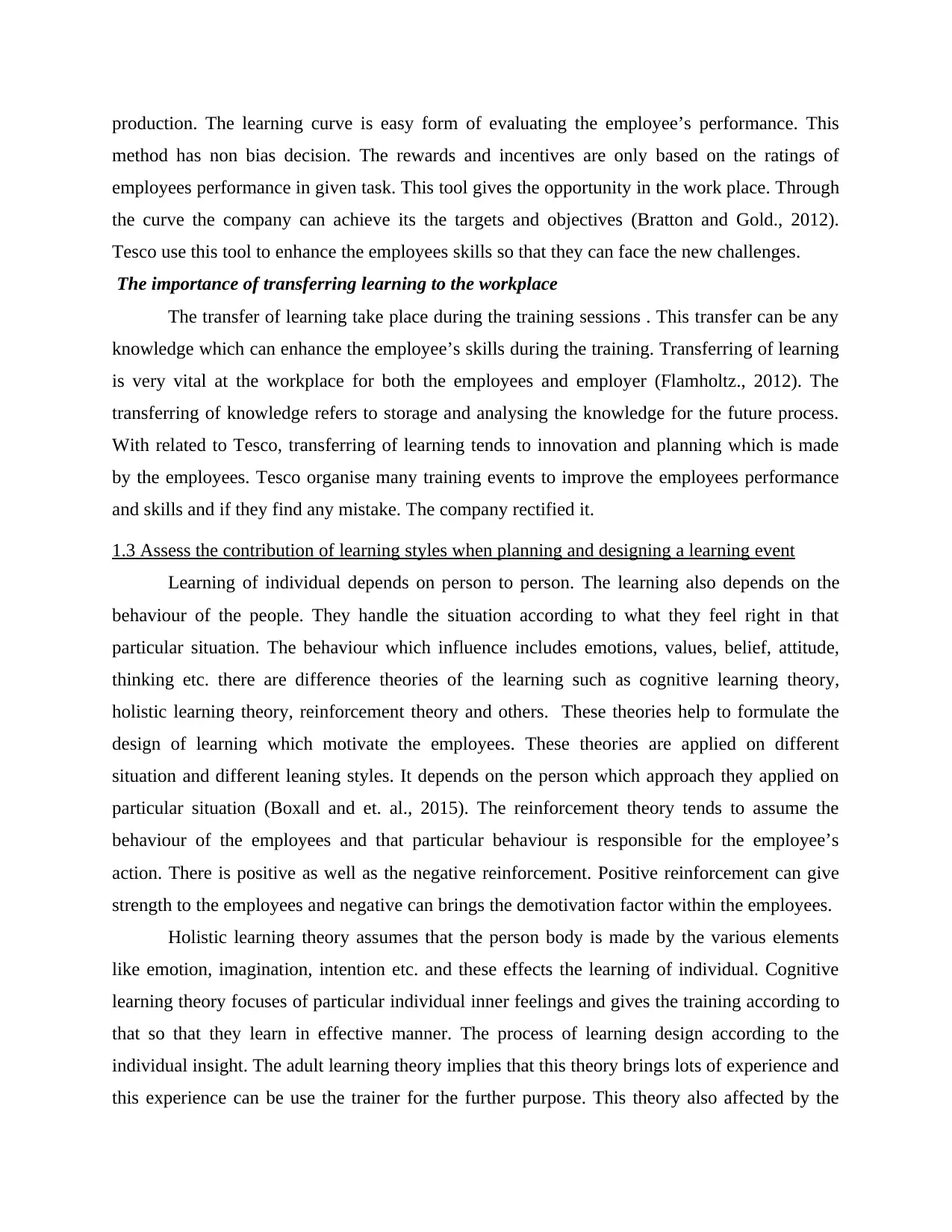
production. The learning curve is easy form of evaluating the employee’s performance. This
method has non bias decision. The rewards and incentives are only based on the ratings of
employees performance in given task. This tool gives the opportunity in the work place. Through
the curve the company can achieve its the targets and objectives (Bratton and Gold., 2012).
Tesco use this tool to enhance the employees skills so that they can face the new challenges.
The importance of transferring learning to the workplace
The transfer of learning take place during the training sessions . This transfer can be any
knowledge which can enhance the employee’s skills during the training. Transferring of learning
is very vital at the workplace for both the employees and employer (Flamholtz., 2012). The
transferring of knowledge refers to storage and analysing the knowledge for the future process.
With related to Tesco, transferring of learning tends to innovation and planning which is made
by the employees. Tesco organise many training events to improve the employees performance
and skills and if they find any mistake. The company rectified it.
1.3 Assess the contribution of learning styles when planning and designing a learning event
Learning of individual depends on person to person. The learning also depends on the
behaviour of the people. They handle the situation according to what they feel right in that
particular situation. The behaviour which influence includes emotions, values, belief, attitude,
thinking etc. there are difference theories of the learning such as cognitive learning theory,
holistic learning theory, reinforcement theory and others. These theories help to formulate the
design of learning which motivate the employees. These theories are applied on different
situation and different leaning styles. It depends on the person which approach they applied on
particular situation (Boxall and et. al., 2015). The reinforcement theory tends to assume the
behaviour of the employees and that particular behaviour is responsible for the employee’s
action. There is positive as well as the negative reinforcement. Positive reinforcement can give
strength to the employees and negative can brings the demotivation factor within the employees.
Holistic learning theory assumes that the person body is made by the various elements
like emotion, imagination, intention etc. and these effects the learning of individual. Cognitive
learning theory focuses of particular individual inner feelings and gives the training according to
that so that they learn in effective manner. The process of learning design according to the
individual insight. The adult learning theory implies that this theory brings lots of experience and
this experience can be use the trainer for the further purpose. This theory also affected by the
method has non bias decision. The rewards and incentives are only based on the ratings of
employees performance in given task. This tool gives the opportunity in the work place. Through
the curve the company can achieve its the targets and objectives (Bratton and Gold., 2012).
Tesco use this tool to enhance the employees skills so that they can face the new challenges.
The importance of transferring learning to the workplace
The transfer of learning take place during the training sessions . This transfer can be any
knowledge which can enhance the employee’s skills during the training. Transferring of learning
is very vital at the workplace for both the employees and employer (Flamholtz., 2012). The
transferring of knowledge refers to storage and analysing the knowledge for the future process.
With related to Tesco, transferring of learning tends to innovation and planning which is made
by the employees. Tesco organise many training events to improve the employees performance
and skills and if they find any mistake. The company rectified it.
1.3 Assess the contribution of learning styles when planning and designing a learning event
Learning of individual depends on person to person. The learning also depends on the
behaviour of the people. They handle the situation according to what they feel right in that
particular situation. The behaviour which influence includes emotions, values, belief, attitude,
thinking etc. there are difference theories of the learning such as cognitive learning theory,
holistic learning theory, reinforcement theory and others. These theories help to formulate the
design of learning which motivate the employees. These theories are applied on different
situation and different leaning styles. It depends on the person which approach they applied on
particular situation (Boxall and et. al., 2015). The reinforcement theory tends to assume the
behaviour of the employees and that particular behaviour is responsible for the employee’s
action. There is positive as well as the negative reinforcement. Positive reinforcement can give
strength to the employees and negative can brings the demotivation factor within the employees.
Holistic learning theory assumes that the person body is made by the various elements
like emotion, imagination, intention etc. and these effects the learning of individual. Cognitive
learning theory focuses of particular individual inner feelings and gives the training according to
that so that they learn in effective manner. The process of learning design according to the
individual insight. The adult learning theory implies that this theory brings lots of experience and
this experience can be use the trainer for the further purpose. This theory also affected by the
⊘ This is a preview!⊘
Do you want full access?
Subscribe today to unlock all pages.

Trusted by 1+ million students worldwide
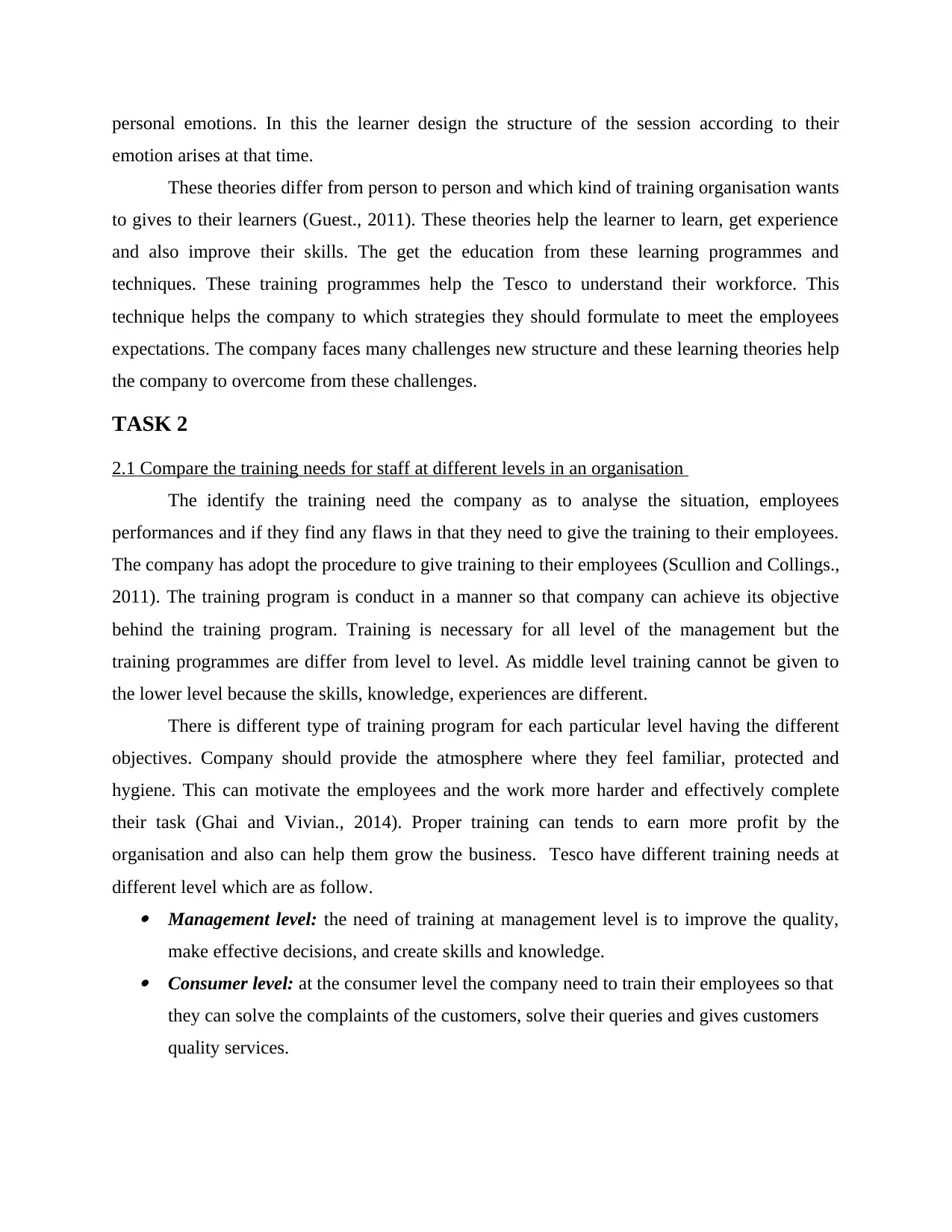
personal emotions. In this the learner design the structure of the session according to their
emotion arises at that time.
These theories differ from person to person and which kind of training organisation wants
to gives to their learners (Guest., 2011). These theories help the learner to learn, get experience
and also improve their skills. The get the education from these learning programmes and
techniques. These training programmes help the Tesco to understand their workforce. This
technique helps the company to which strategies they should formulate to meet the employees
expectations. The company faces many challenges new structure and these learning theories help
the company to overcome from these challenges.
TASK 2
2.1 Compare the training needs for staff at different levels in an organisation
The identify the training need the company as to analyse the situation, employees
performances and if they find any flaws in that they need to give the training to their employees.
The company has adopt the procedure to give training to their employees (Scullion and Collings.,
2011). The training program is conduct in a manner so that company can achieve its objective
behind the training program. Training is necessary for all level of the management but the
training programmes are differ from level to level. As middle level training cannot be given to
the lower level because the skills, knowledge, experiences are different.
There is different type of training program for each particular level having the different
objectives. Company should provide the atmosphere where they feel familiar, protected and
hygiene. This can motivate the employees and the work more harder and effectively complete
their task (Ghai and Vivian., 2014). Proper training can tends to earn more profit by the
organisation and also can help them grow the business. Tesco have different training needs at
different level which are as follow. Management level: the need of training at management level is to improve the quality,
make effective decisions, and create skills and knowledge. Consumer level: at the consumer level the company need to train their employees so that
they can solve the complaints of the customers, solve their queries and gives customers
quality services.
emotion arises at that time.
These theories differ from person to person and which kind of training organisation wants
to gives to their learners (Guest., 2011). These theories help the learner to learn, get experience
and also improve their skills. The get the education from these learning programmes and
techniques. These training programmes help the Tesco to understand their workforce. This
technique helps the company to which strategies they should formulate to meet the employees
expectations. The company faces many challenges new structure and these learning theories help
the company to overcome from these challenges.
TASK 2
2.1 Compare the training needs for staff at different levels in an organisation
The identify the training need the company as to analyse the situation, employees
performances and if they find any flaws in that they need to give the training to their employees.
The company has adopt the procedure to give training to their employees (Scullion and Collings.,
2011). The training program is conduct in a manner so that company can achieve its objective
behind the training program. Training is necessary for all level of the management but the
training programmes are differ from level to level. As middle level training cannot be given to
the lower level because the skills, knowledge, experiences are different.
There is different type of training program for each particular level having the different
objectives. Company should provide the atmosphere where they feel familiar, protected and
hygiene. This can motivate the employees and the work more harder and effectively complete
their task (Ghai and Vivian., 2014). Proper training can tends to earn more profit by the
organisation and also can help them grow the business. Tesco have different training needs at
different level which are as follow. Management level: the need of training at management level is to improve the quality,
make effective decisions, and create skills and knowledge. Consumer level: at the consumer level the company need to train their employees so that
they can solve the complaints of the customers, solve their queries and gives customers
quality services.
Paraphrase This Document
Need a fresh take? Get an instant paraphrase of this document with our AI Paraphraser
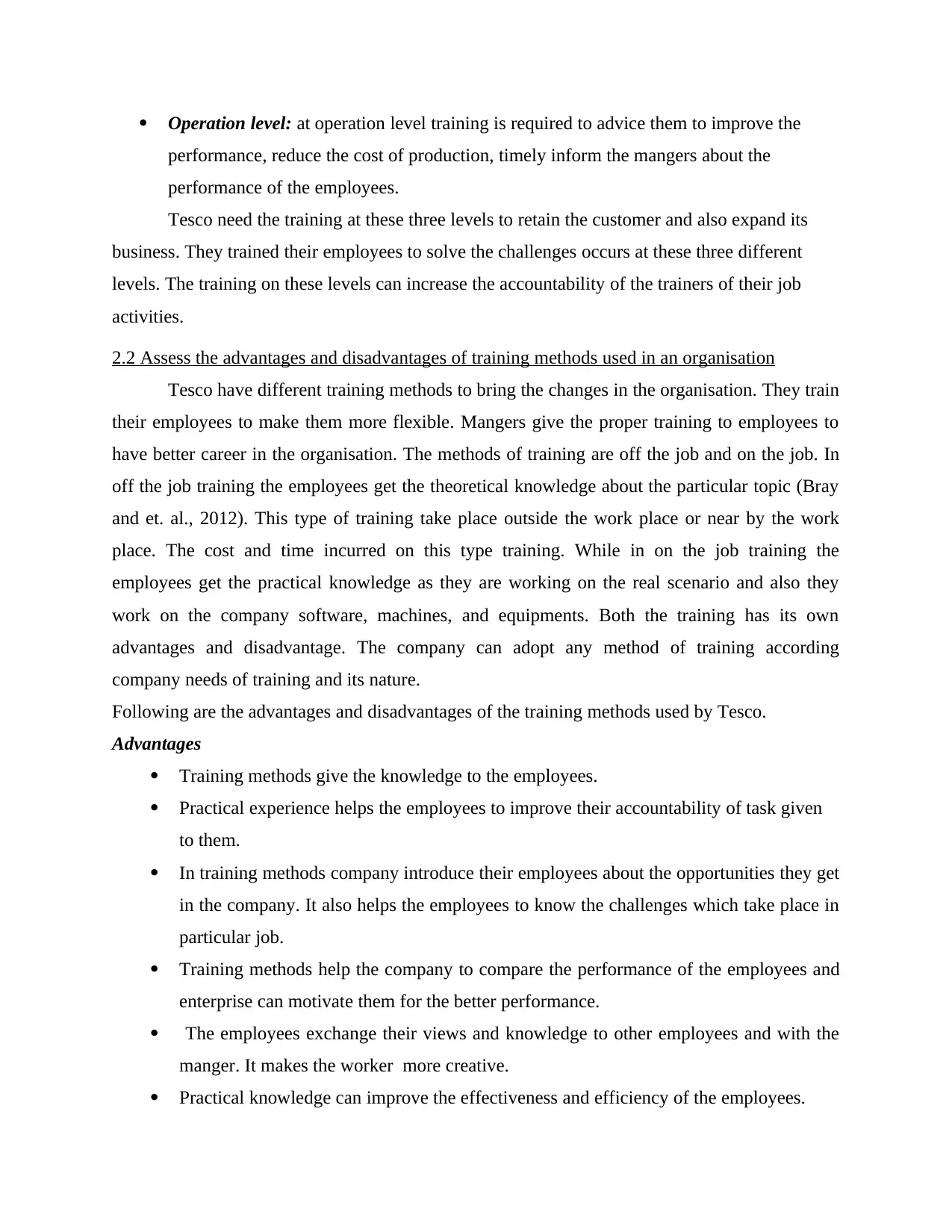
Operation level: at operation level training is required to advice them to improve the
performance, reduce the cost of production, timely inform the mangers about the
performance of the employees.
Tesco need the training at these three levels to retain the customer and also expand its
business. They trained their employees to solve the challenges occurs at these three different
levels. The training on these levels can increase the accountability of the trainers of their job
activities.
2.2 Assess the advantages and disadvantages of training methods used in an organisation
Tesco have different training methods to bring the changes in the organisation. They train
their employees to make them more flexible. Mangers give the proper training to employees to
have better career in the organisation. The methods of training are off the job and on the job. In
off the job training the employees get the theoretical knowledge about the particular topic (Bray
and et. al., 2012). This type of training take place outside the work place or near by the work
place. The cost and time incurred on this type training. While in on the job training the
employees get the practical knowledge as they are working on the real scenario and also they
work on the company software, machines, and equipments. Both the training has its own
advantages and disadvantage. The company can adopt any method of training according
company needs of training and its nature.
Following are the advantages and disadvantages of the training methods used by Tesco.
Advantages
Training methods give the knowledge to the employees.
Practical experience helps the employees to improve their accountability of task given
to them.
In training methods company introduce their employees about the opportunities they get
in the company. It also helps the employees to know the challenges which take place in
particular job.
Training methods help the company to compare the performance of the employees and
enterprise can motivate them for the better performance.
The employees exchange their views and knowledge to other employees and with the
manger. It makes the worker more creative.
Practical knowledge can improve the effectiveness and efficiency of the employees.
performance, reduce the cost of production, timely inform the mangers about the
performance of the employees.
Tesco need the training at these three levels to retain the customer and also expand its
business. They trained their employees to solve the challenges occurs at these three different
levels. The training on these levels can increase the accountability of the trainers of their job
activities.
2.2 Assess the advantages and disadvantages of training methods used in an organisation
Tesco have different training methods to bring the changes in the organisation. They train
their employees to make them more flexible. Mangers give the proper training to employees to
have better career in the organisation. The methods of training are off the job and on the job. In
off the job training the employees get the theoretical knowledge about the particular topic (Bray
and et. al., 2012). This type of training take place outside the work place or near by the work
place. The cost and time incurred on this type training. While in on the job training the
employees get the practical knowledge as they are working on the real scenario and also they
work on the company software, machines, and equipments. Both the training has its own
advantages and disadvantage. The company can adopt any method of training according
company needs of training and its nature.
Following are the advantages and disadvantages of the training methods used by Tesco.
Advantages
Training methods give the knowledge to the employees.
Practical experience helps the employees to improve their accountability of task given
to them.
In training methods company introduce their employees about the opportunities they get
in the company. It also helps the employees to know the challenges which take place in
particular job.
Training methods help the company to compare the performance of the employees and
enterprise can motivate them for the better performance.
The employees exchange their views and knowledge to other employees and with the
manger. It makes the worker more creative.
Practical knowledge can improve the effectiveness and efficiency of the employees.
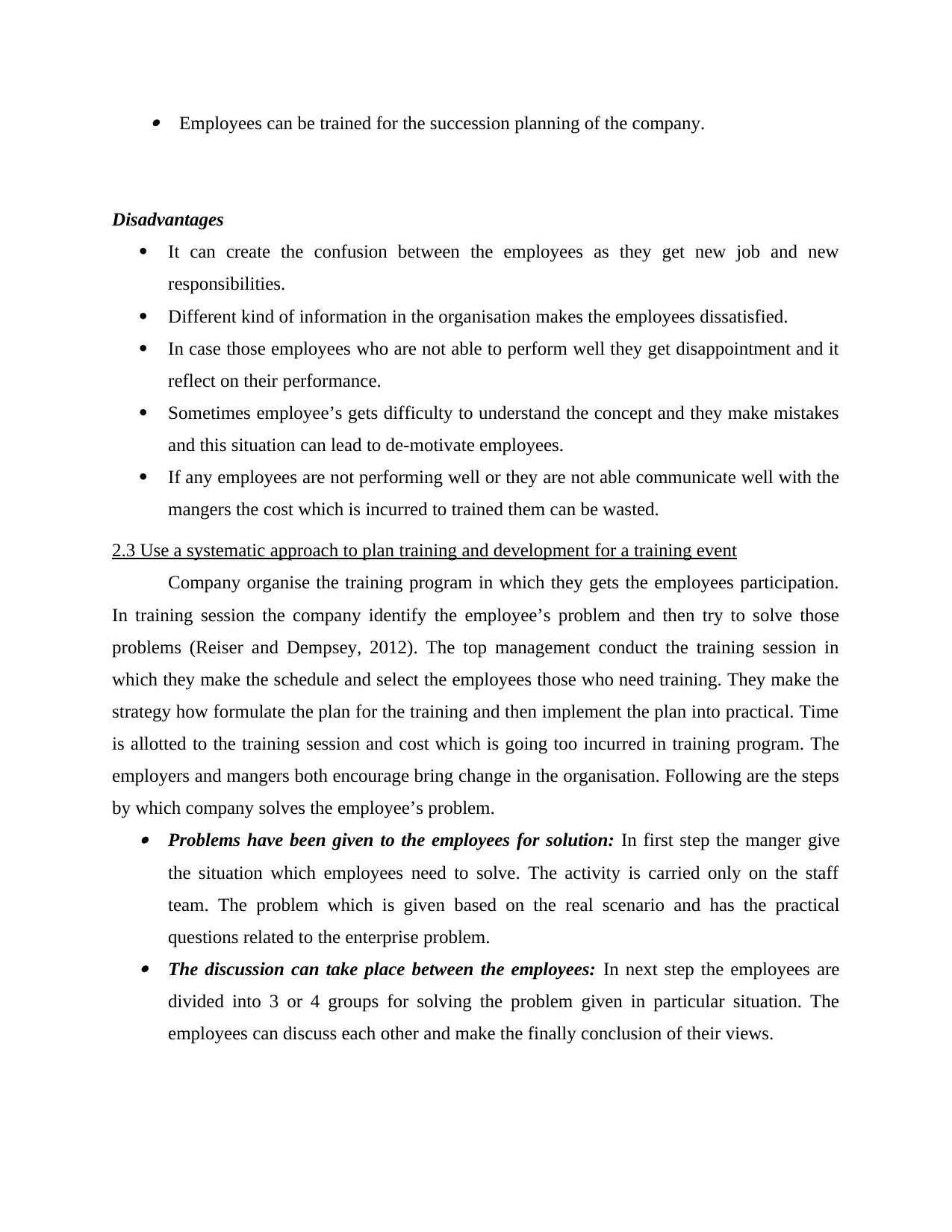
Employees can be trained for the succession planning of the company.
Disadvantages
It can create the confusion between the employees as they get new job and new
responsibilities.
Different kind of information in the organisation makes the employees dissatisfied.
In case those employees who are not able to perform well they get disappointment and it
reflect on their performance.
Sometimes employee’s gets difficulty to understand the concept and they make mistakes
and this situation can lead to de-motivate employees.
If any employees are not performing well or they are not able communicate well with the
mangers the cost which is incurred to trained them can be wasted.
2.3 Use a systematic approach to plan training and development for a training event
Company organise the training program in which they gets the employees participation.
In training session the company identify the employee’s problem and then try to solve those
problems (Reiser and Dempsey, 2012). The top management conduct the training session in
which they make the schedule and select the employees those who need training. They make the
strategy how formulate the plan for the training and then implement the plan into practical. Time
is allotted to the training session and cost which is going too incurred in training program. The
employers and mangers both encourage bring change in the organisation. Following are the steps
by which company solves the employee’s problem. Problems have been given to the employees for solution: In first step the manger give
the situation which employees need to solve. The activity is carried only on the staff
team. The problem which is given based on the real scenario and has the practical
questions related to the enterprise problem. The discussion can take place between the employees: In next step the employees are
divided into 3 or 4 groups for solving the problem given in particular situation. The
employees can discuss each other and make the finally conclusion of their views.
Disadvantages
It can create the confusion between the employees as they get new job and new
responsibilities.
Different kind of information in the organisation makes the employees dissatisfied.
In case those employees who are not able to perform well they get disappointment and it
reflect on their performance.
Sometimes employee’s gets difficulty to understand the concept and they make mistakes
and this situation can lead to de-motivate employees.
If any employees are not performing well or they are not able communicate well with the
mangers the cost which is incurred to trained them can be wasted.
2.3 Use a systematic approach to plan training and development for a training event
Company organise the training program in which they gets the employees participation.
In training session the company identify the employee’s problem and then try to solve those
problems (Reiser and Dempsey, 2012). The top management conduct the training session in
which they make the schedule and select the employees those who need training. They make the
strategy how formulate the plan for the training and then implement the plan into practical. Time
is allotted to the training session and cost which is going too incurred in training program. The
employers and mangers both encourage bring change in the organisation. Following are the steps
by which company solves the employee’s problem. Problems have been given to the employees for solution: In first step the manger give
the situation which employees need to solve. The activity is carried only on the staff
team. The problem which is given based on the real scenario and has the practical
questions related to the enterprise problem. The discussion can take place between the employees: In next step the employees are
divided into 3 or 4 groups for solving the problem given in particular situation. The
employees can discuss each other and make the finally conclusion of their views.
⊘ This is a preview!⊘
Do you want full access?
Subscribe today to unlock all pages.

Trusted by 1+ million students worldwide
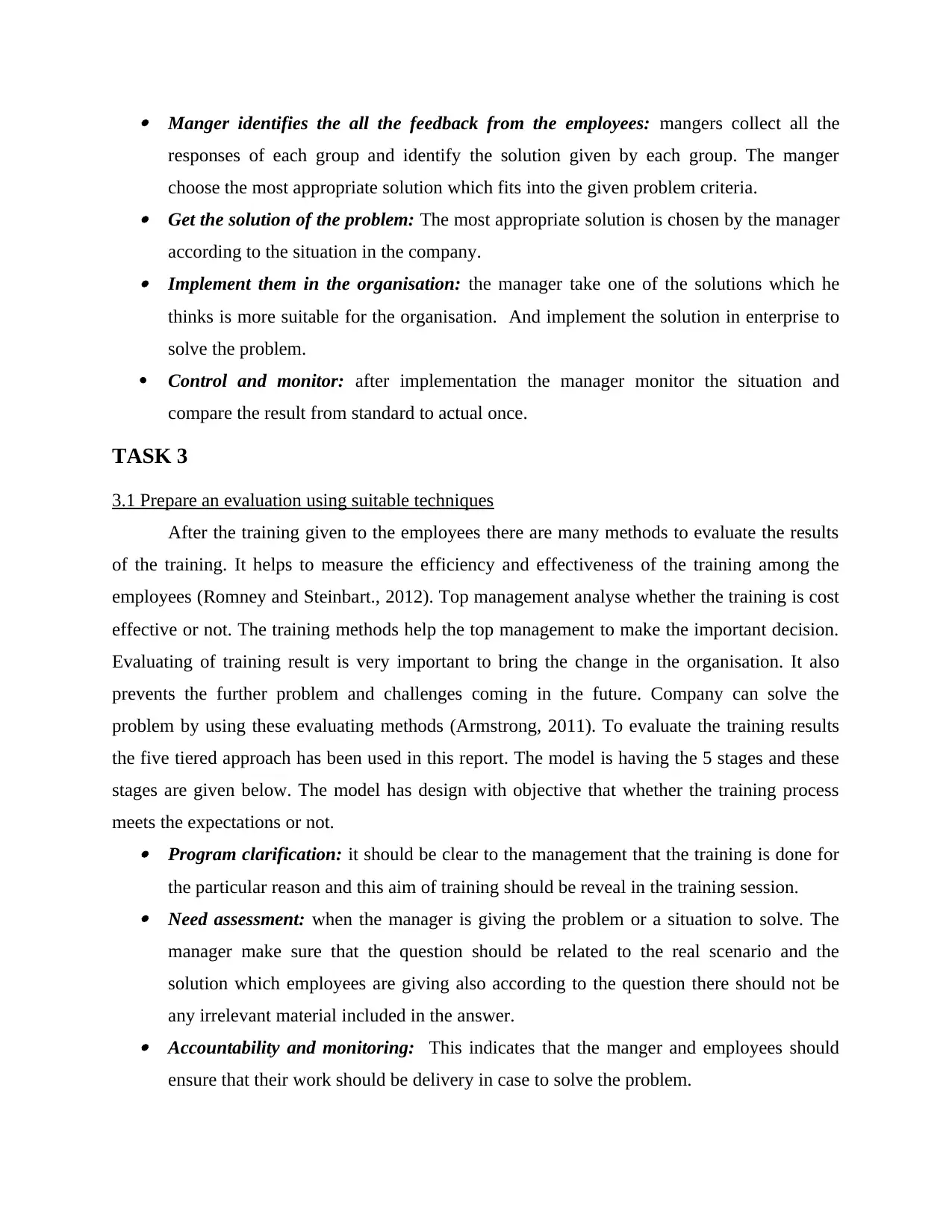
Manger identifies the all the feedback from the employees: mangers collect all the
responses of each group and identify the solution given by each group. The manger
choose the most appropriate solution which fits into the given problem criteria. Get the solution of the problem: The most appropriate solution is chosen by the manager
according to the situation in the company. Implement them in the organisation: the manager take one of the solutions which he
thinks is more suitable for the organisation. And implement the solution in enterprise to
solve the problem.
Control and monitor: after implementation the manager monitor the situation and
compare the result from standard to actual once.
TASK 3
3.1 Prepare an evaluation using suitable techniques
After the training given to the employees there are many methods to evaluate the results
of the training. It helps to measure the efficiency and effectiveness of the training among the
employees (Romney and Steinbart., 2012). Top management analyse whether the training is cost
effective or not. The training methods help the top management to make the important decision.
Evaluating of training result is very important to bring the change in the organisation. It also
prevents the further problem and challenges coming in the future. Company can solve the
problem by using these evaluating methods (Armstrong, 2011). To evaluate the training results
the five tiered approach has been used in this report. The model is having the 5 stages and these
stages are given below. The model has design with objective that whether the training process
meets the expectations or not. Program clarification: it should be clear to the management that the training is done for
the particular reason and this aim of training should be reveal in the training session. Need assessment: when the manager is giving the problem or a situation to solve. The
manager make sure that the question should be related to the real scenario and the
solution which employees are giving also according to the question there should not be
any irrelevant material included in the answer. Accountability and monitoring: This indicates that the manger and employees should
ensure that their work should be delivery in case to solve the problem.
responses of each group and identify the solution given by each group. The manger
choose the most appropriate solution which fits into the given problem criteria. Get the solution of the problem: The most appropriate solution is chosen by the manager
according to the situation in the company. Implement them in the organisation: the manager take one of the solutions which he
thinks is more suitable for the organisation. And implement the solution in enterprise to
solve the problem.
Control and monitor: after implementation the manager monitor the situation and
compare the result from standard to actual once.
TASK 3
3.1 Prepare an evaluation using suitable techniques
After the training given to the employees there are many methods to evaluate the results
of the training. It helps to measure the efficiency and effectiveness of the training among the
employees (Romney and Steinbart., 2012). Top management analyse whether the training is cost
effective or not. The training methods help the top management to make the important decision.
Evaluating of training result is very important to bring the change in the organisation. It also
prevents the further problem and challenges coming in the future. Company can solve the
problem by using these evaluating methods (Armstrong, 2011). To evaluate the training results
the five tiered approach has been used in this report. The model is having the 5 stages and these
stages are given below. The model has design with objective that whether the training process
meets the expectations or not. Program clarification: it should be clear to the management that the training is done for
the particular reason and this aim of training should be reveal in the training session. Need assessment: when the manager is giving the problem or a situation to solve. The
manager make sure that the question should be related to the real scenario and the
solution which employees are giving also according to the question there should not be
any irrelevant material included in the answer. Accountability and monitoring: This indicates that the manger and employees should
ensure that their work should be delivery in case to solve the problem.
Paraphrase This Document
Need a fresh take? Get an instant paraphrase of this document with our AI Paraphraser
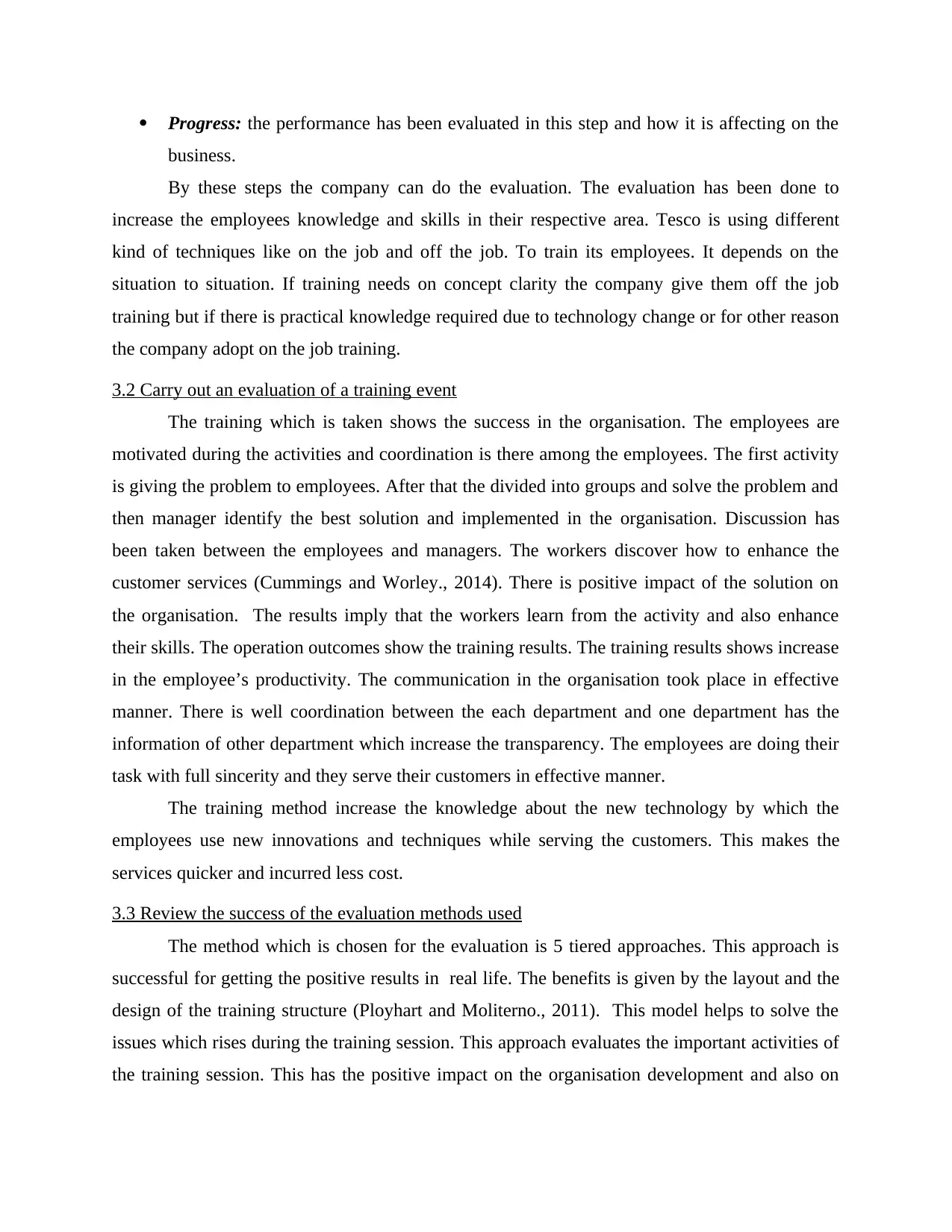
Progress: the performance has been evaluated in this step and how it is affecting on the
business.
By these steps the company can do the evaluation. The evaluation has been done to
increase the employees knowledge and skills in their respective area. Tesco is using different
kind of techniques like on the job and off the job. To train its employees. It depends on the
situation to situation. If training needs on concept clarity the company give them off the job
training but if there is practical knowledge required due to technology change or for other reason
the company adopt on the job training.
3.2 Carry out an evaluation of a training event
The training which is taken shows the success in the organisation. The employees are
motivated during the activities and coordination is there among the employees. The first activity
is giving the problem to employees. After that the divided into groups and solve the problem and
then manager identify the best solution and implemented in the organisation. Discussion has
been taken between the employees and managers. The workers discover how to enhance the
customer services (Cummings and Worley., 2014). There is positive impact of the solution on
the organisation. The results imply that the workers learn from the activity and also enhance
their skills. The operation outcomes show the training results. The training results shows increase
in the employee’s productivity. The communication in the organisation took place in effective
manner. There is well coordination between the each department and one department has the
information of other department which increase the transparency. The employees are doing their
task with full sincerity and they serve their customers in effective manner.
The training method increase the knowledge about the new technology by which the
employees use new innovations and techniques while serving the customers. This makes the
services quicker and incurred less cost.
3.3 Review the success of the evaluation methods used
The method which is chosen for the evaluation is 5 tiered approaches. This approach is
successful for getting the positive results in real life. The benefits is given by the layout and the
design of the training structure (Ployhart and Moliterno., 2011). This model helps to solve the
issues which rises during the training session. This approach evaluates the important activities of
the training session. This has the positive impact on the organisation development and also on
business.
By these steps the company can do the evaluation. The evaluation has been done to
increase the employees knowledge and skills in their respective area. Tesco is using different
kind of techniques like on the job and off the job. To train its employees. It depends on the
situation to situation. If training needs on concept clarity the company give them off the job
training but if there is practical knowledge required due to technology change or for other reason
the company adopt on the job training.
3.2 Carry out an evaluation of a training event
The training which is taken shows the success in the organisation. The employees are
motivated during the activities and coordination is there among the employees. The first activity
is giving the problem to employees. After that the divided into groups and solve the problem and
then manager identify the best solution and implemented in the organisation. Discussion has
been taken between the employees and managers. The workers discover how to enhance the
customer services (Cummings and Worley., 2014). There is positive impact of the solution on
the organisation. The results imply that the workers learn from the activity and also enhance
their skills. The operation outcomes show the training results. The training results shows increase
in the employee’s productivity. The communication in the organisation took place in effective
manner. There is well coordination between the each department and one department has the
information of other department which increase the transparency. The employees are doing their
task with full sincerity and they serve their customers in effective manner.
The training method increase the knowledge about the new technology by which the
employees use new innovations and techniques while serving the customers. This makes the
services quicker and incurred less cost.
3.3 Review the success of the evaluation methods used
The method which is chosen for the evaluation is 5 tiered approaches. This approach is
successful for getting the positive results in real life. The benefits is given by the layout and the
design of the training structure (Ployhart and Moliterno., 2011). This model helps to solve the
issues which rises during the training session. This approach evaluates the important activities of
the training session. This has the positive impact on the organisation development and also on
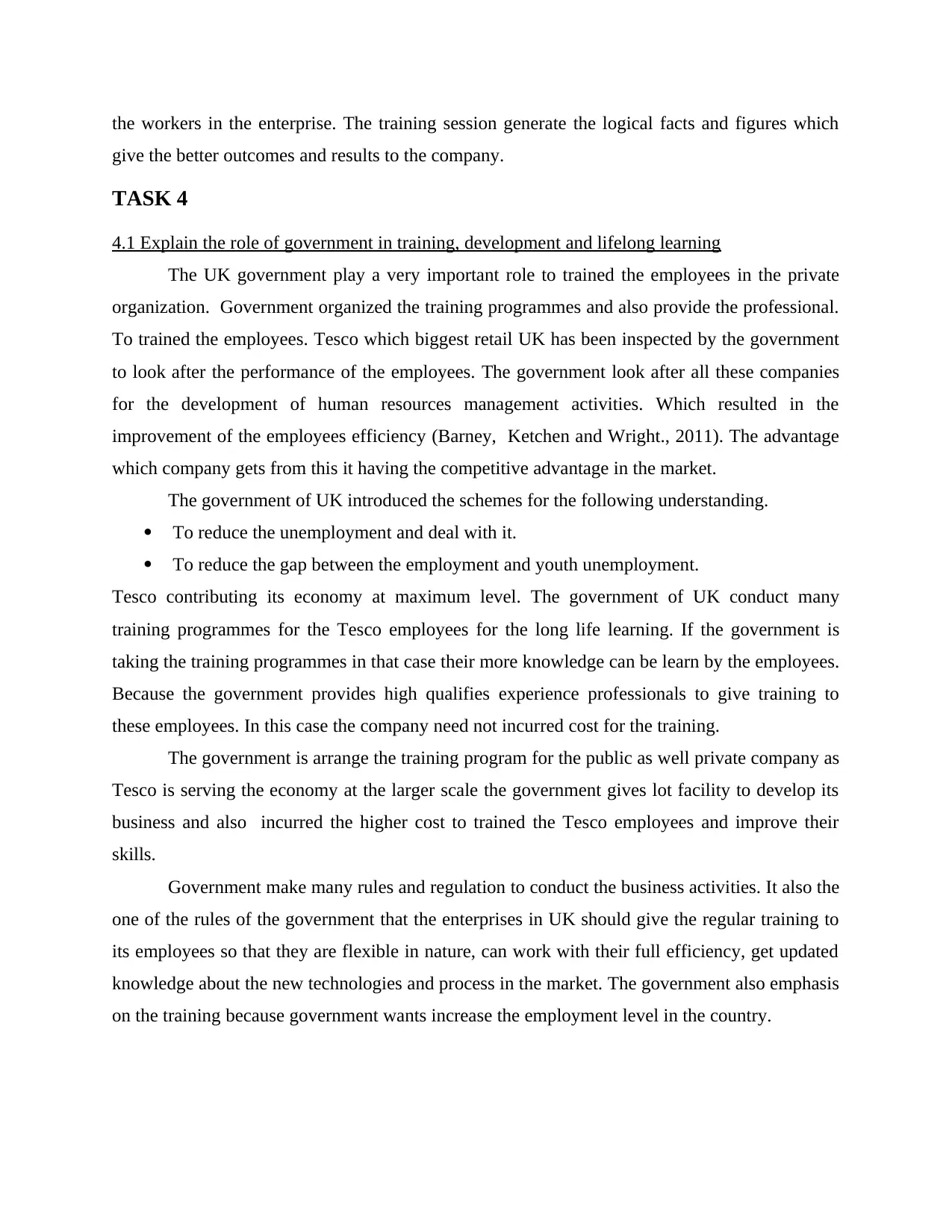
the workers in the enterprise. The training session generate the logical facts and figures which
give the better outcomes and results to the company.
TASK 4
4.1 Explain the role of government in training, development and lifelong learning
The UK government play a very important role to trained the employees in the private
organization. Government organized the training programmes and also provide the professional.
To trained the employees. Tesco which biggest retail UK has been inspected by the government
to look after the performance of the employees. The government look after all these companies
for the development of human resources management activities. Which resulted in the
improvement of the employees efficiency (Barney, Ketchen and Wright., 2011). The advantage
which company gets from this it having the competitive advantage in the market.
The government of UK introduced the schemes for the following understanding.
To reduce the unemployment and deal with it.
To reduce the gap between the employment and youth unemployment.
Tesco contributing its economy at maximum level. The government of UK conduct many
training programmes for the Tesco employees for the long life learning. If the government is
taking the training programmes in that case their more knowledge can be learn by the employees.
Because the government provides high qualifies experience professionals to give training to
these employees. In this case the company need not incurred cost for the training.
The government is arrange the training program for the public as well private company as
Tesco is serving the economy at the larger scale the government gives lot facility to develop its
business and also incurred the higher cost to trained the Tesco employees and improve their
skills.
Government make many rules and regulation to conduct the business activities. It also the
one of the rules of the government that the enterprises in UK should give the regular training to
its employees so that they are flexible in nature, can work with their full efficiency, get updated
knowledge about the new technologies and process in the market. The government also emphasis
on the training because government wants increase the employment level in the country.
give the better outcomes and results to the company.
TASK 4
4.1 Explain the role of government in training, development and lifelong learning
The UK government play a very important role to trained the employees in the private
organization. Government organized the training programmes and also provide the professional.
To trained the employees. Tesco which biggest retail UK has been inspected by the government
to look after the performance of the employees. The government look after all these companies
for the development of human resources management activities. Which resulted in the
improvement of the employees efficiency (Barney, Ketchen and Wright., 2011). The advantage
which company gets from this it having the competitive advantage in the market.
The government of UK introduced the schemes for the following understanding.
To reduce the unemployment and deal with it.
To reduce the gap between the employment and youth unemployment.
Tesco contributing its economy at maximum level. The government of UK conduct many
training programmes for the Tesco employees for the long life learning. If the government is
taking the training programmes in that case their more knowledge can be learn by the employees.
Because the government provides high qualifies experience professionals to give training to
these employees. In this case the company need not incurred cost for the training.
The government is arrange the training program for the public as well private company as
Tesco is serving the economy at the larger scale the government gives lot facility to develop its
business and also incurred the higher cost to trained the Tesco employees and improve their
skills.
Government make many rules and regulation to conduct the business activities. It also the
one of the rules of the government that the enterprises in UK should give the regular training to
its employees so that they are flexible in nature, can work with their full efficiency, get updated
knowledge about the new technologies and process in the market. The government also emphasis
on the training because government wants increase the employment level in the country.
⊘ This is a preview!⊘
Do you want full access?
Subscribe today to unlock all pages.

Trusted by 1+ million students worldwide
1 out of 18
Related Documents
Your All-in-One AI-Powered Toolkit for Academic Success.
+13062052269
info@desklib.com
Available 24*7 on WhatsApp / Email
![[object Object]](/_next/static/media/star-bottom.7253800d.svg)
Unlock your academic potential
Copyright © 2020–2025 A2Z Services. All Rights Reserved. Developed and managed by ZUCOL.





